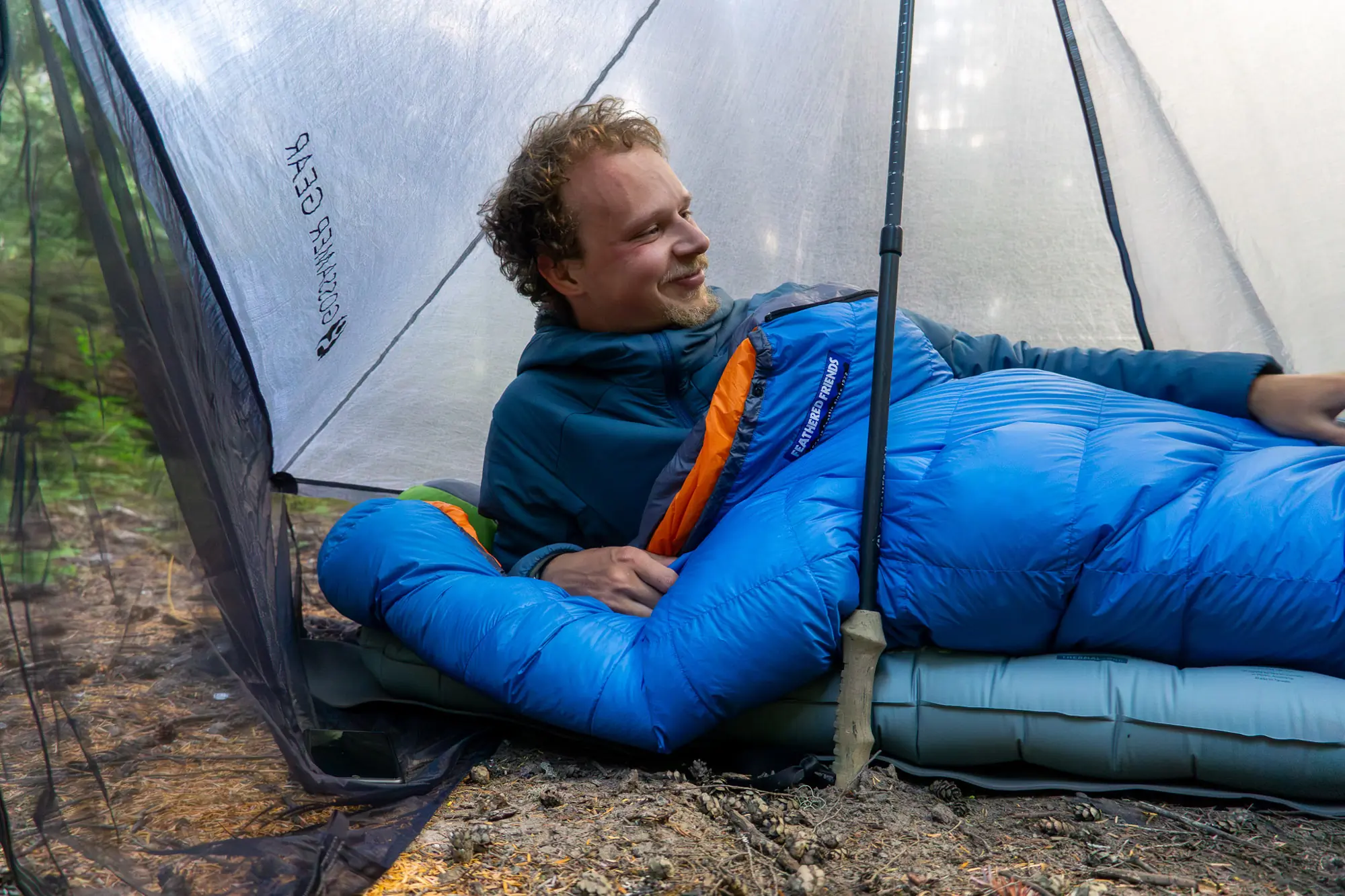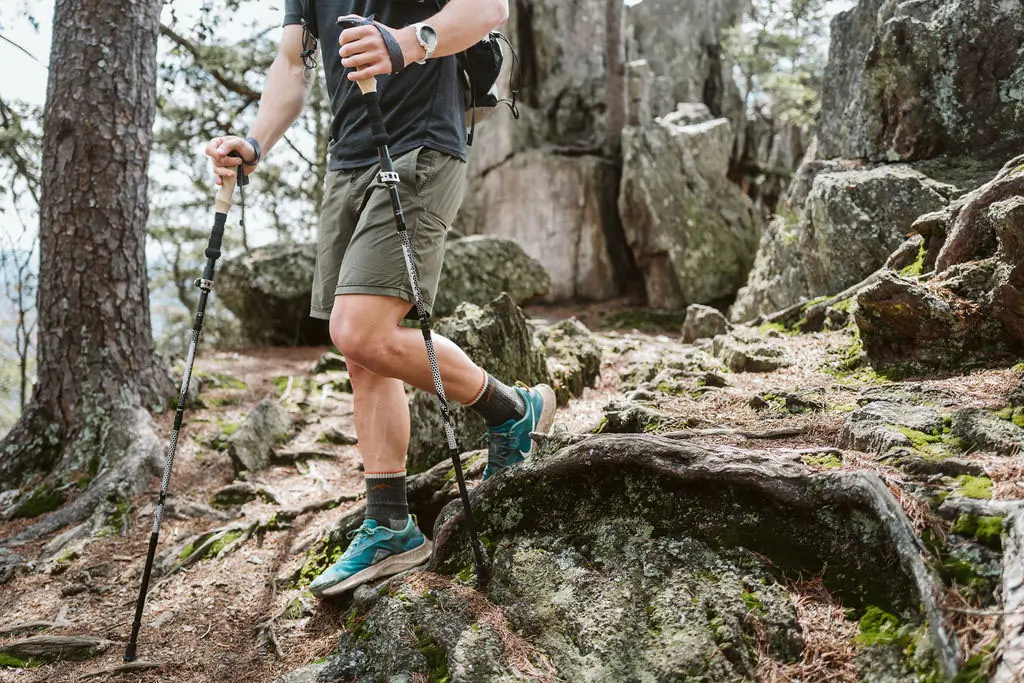Two of Osprey’s most anticipated packs, the Levity and Lumina, hit the market this spring. We got our hands on a Levity 45 to see how the ultralight pack carries.
Osprey enters the ultralight realm this spring, and it feels so good. The Levity (men’s) and Lumina (women’s) packs breathe fresh design into a category dominated by cottage manufacturers.
This is a first look at the pack and not a complete review. For an initial impression, I carried it 5 miles over steep trails loaded with about 20 pounds of gear.
In short: The Osprey Levity and Lumina are sub-two-pound packs that carry remarkably well. But they are prone to abrasion and limited to loads under about 25 pounds. This pack is a focused design for dedicated gram counters willing to sacrifice features and durability for featherweight gear hauling.
Osprey Levity and Lumina

Osprey announced these packs at the Outdoor Retailer Summer Market in 2017, and boy did they get attention. GearJunkie (and basically every other media outlet) awarded the pack Best In Show, and for good reason.
It put Osprey squarely in the ultralight realm. Check out the insanely light weights (and expensive prices) for the four available models below. (All weights are given in size medium.)
Osprey Lumina 60: 3,661 cubic inches/60 liters; 1.949 pounds; $270
Osprey Lumina 45: 2,746 cubic inches/45 liters; 1.85 pounds; $250
Osprey Levity 60: 3,661 cubic inches/60 liters; 1.951 pounds; $270
Osprey Levity 45: 2746 cubic inches/45 liters; 1.852 pounds; $250
It’s worth noting that the Levity sells in sizes small, medium, and large. The Lumina sells in sizes extra small, small, and medium, with no large offered. Odd? I think yes. Not sure if it’s marketing or actual design, but if you happen to be a taller woman, plan on getting the Levity.
The Levity and Lumina are top-loading packs. They have a zippered-pocket in the top lid. They also have a stuff-pocket space between the main body and external, tougher fabric of the pack. It’s a unique design, but gives a spot to stash jackets.
You can stash a water bottle behind your hips in this same area, and remove it with two hands on the go. There are daisy chain lash points on the back. And that’s about it. Don’t look for fancy hip belt pockets, etc. They aren’t there because it saves weight.
Durability: The Elephant in the Room
Let’s just get this right out – this pack is not for everyone. The Lumina and Levity use a light 30-denier Cordura silnylon ripstop. This silicone-infused nylon is commonly used in tents, but not backpacks.

Osprey used the silnylon smartly as an interior part of the pack. Most high-abrasion areas are built with 210-denier nylon reinforced with 200-denier ultra-high-molecular-weight polyethylene (UHMWPE), the same substance used to make stronger-than-steel Dyneema.
But even with the majority of the pack’s outermost-facing parts fairly well-protected, this is not a particularly rugged pack. If you’re hard on gear, bushwhack off trail, or carry loads over about 25 pounds, these packs are not for you.
It is worth noting that Osprey warranties its gear for life, which may factor into buying decisions.
Osprey Levity and Lumina Testing: How They Carry
I loaded up the Levity 45 with about 20 pounds of gear – bear canister, sleeping bag, clothing, and a couple bottles of water for weight – and hit a trail near my house for a fast 5-mile jaunt.
The pack carried admirably. Unlike a lot of ultralight packs, the Levity (and Lumina) have very structured frames. The Levity’s aluminum frame holds the body of the pack about three inches away from your back, with very open mesh making contact with your body. This gives awesome ventilation.
But it also results in a somewhat bouncy ride. The Levity generally moves well with the body, but you will feel it springing a little during quick movement. It’s not bothersome, but different than packs with simpler suspensions.
Overall, with a light load, I’d expect this pack to carry great for long distances. I have not tested for very far yet and will update the article as I put in more miles.

For weights much over 20 pounds, I would not use the Levity. The suspension is very minimal, and I worry that heavy weight might even damage it.
Who Should Buy the Levity and Lumina?
If you count in grams, this one might be for you. If you count in pounds, you might want to pass.
Minimalist hikers looking to shed pack weight while keeping the advanced suspension of Osprey designs should consider this pack. To figure out if it is a good fit, consider your backpacking base weight – which includes all your gear except consumables like food, water, and fuel.
A general rule of thumb is that an ultralight hiker carries a base weight under 10 pounds (super light is under 5). I tend to agree that would be a healthy limit for those who carry this pack. A 10-pound base weight (including pack) would leave 15 pounds for food and water. There would even be a little wiggle room, all while staying under the 25-pound hard limit for this pack.
So, if you plan to carry a base weight under 10 pounds, this pack could be for you.
If your base weight would ever exceed about 10 pounds, well, I’d look elsewhere. Many good packs (including many from Osprey) carry heavier loads better.
Still interested? Let’s consider your options.
Osprey Levity and Lumina: Competition
If you’re reading this far, chances are you already know your stuff. But, on the off chance you haven’t been acquainted with the ultralight cottage industry yet, let me introduce you.

There are several quality products in this realm. Examples include the budget-minded but wonderful Mountainsmith Scream 55 (2 pounds 13 ounces; $159) and cottage Gossamer Gear Mariposa 60 (2 pounds; $225). Pricier Dyneema offerings include the Zpacks Arc Blast, with durable fabric and a frame made for loads up to 35 pounds ($325).
Another large brand, Sierra Designs, built its Flex Capacitor ($199) with professional hiker Andrew Skurka. We put it to the test and were impressed with its ability to expand to carry varied load sizes. It weighs 2 pounds 9.2 ounces and can carry a hefty load. Skurka has used it to carry out elk quarters, which top 60 pounds per load.
The list goes on. So, where does that leave Osprey?

To me, the Levity and Lumina are niche tools for those who want a nice suspension in a super light pack. These carry a lot like the Anti-Gravity series of Osprey packs, which work so well some of our testers call them the most comfortable backpacks they’ve worn.
The Levity (and I assume Lumina) is a very comfortable pack. But it’s a niche piece for those moving fast and light.
If you can get past the less-durable fabric used in the inner pack and keep pack loads light, this is one to explore.










